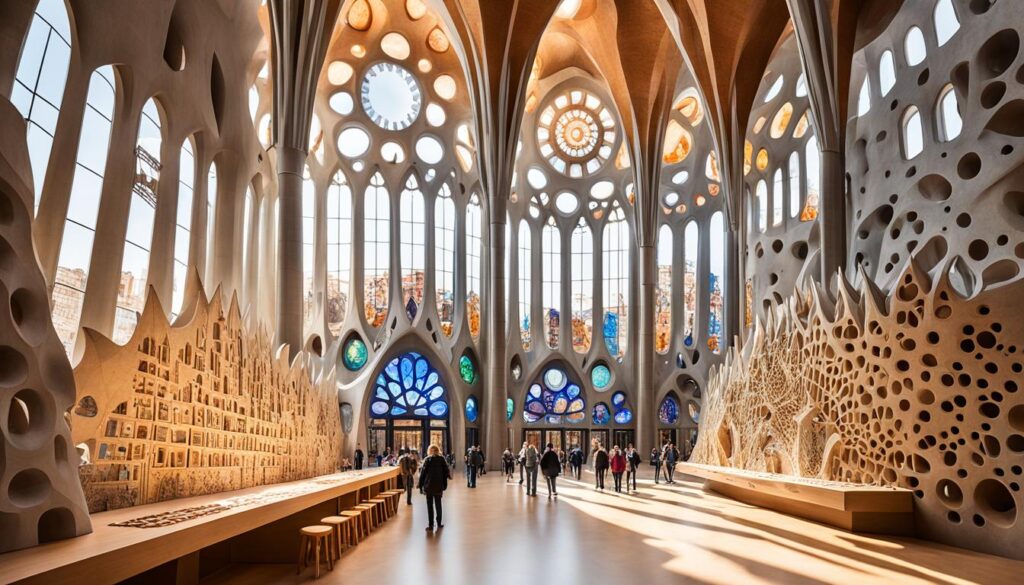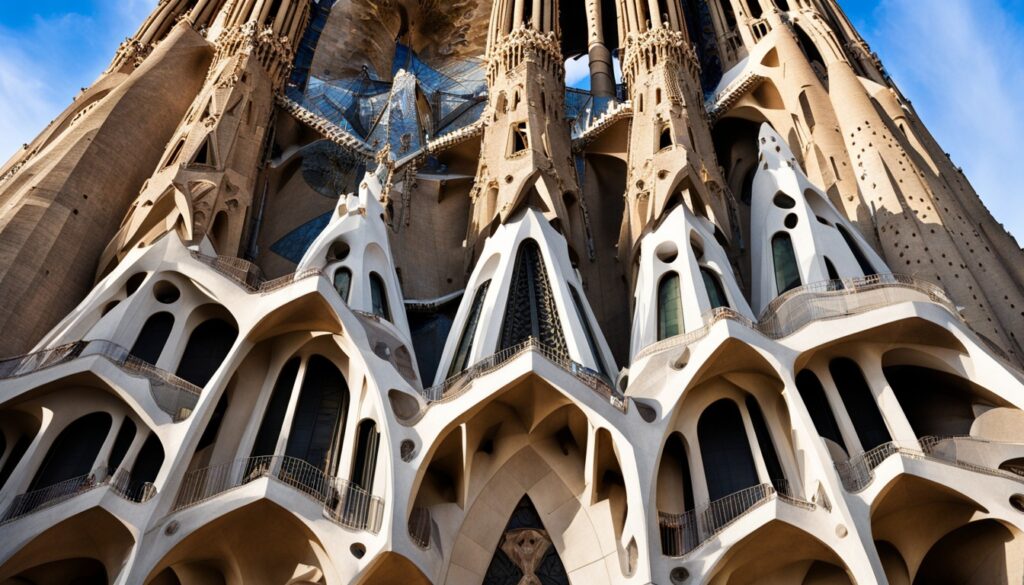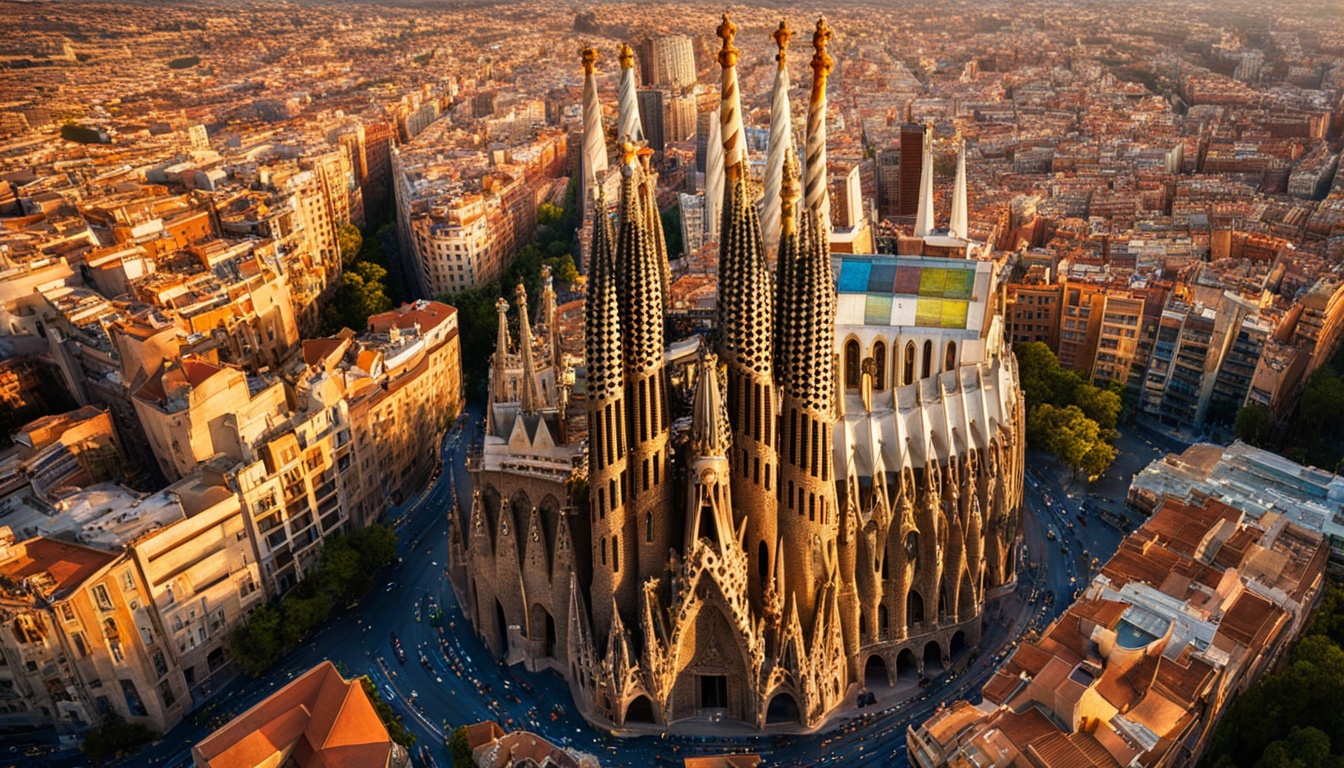The Sagrada Familia stands in the heart of Barcelona, Spain. It’s a masterpiece that draws visitors from all over. Designed by Antoni Gaudí, it mixes Gothic and Art Nouveau styles. This makes it a symbol of Barcelona’s culture.
Gaudí’s unique design is seen in its tall spires and detailed facades. The work started in 1882 and has gone on for over 138 years. It’s set to finish by 2026, marking the 100th year since Gaudí’s death.
Key Takeaways
- The Sagrada Familia is an iconic architectural masterpiece in Barcelona, Spain, designed by the renowned Catalan architect Antoni Gaudí.
- The basilica’s construction began in 1882 and has been an ongoing project for over 138 years, with the completion of the final elements expected by 2026.
- Gaudí’s innovative and organic design philosophy, which blends Gothic and Art Nouveau styles, has made the Sagrada Familia a symbol of Barcelona’s rich cultural heritage.
- The Sagrada Familia is a UNESCO World Heritage Site and one of the most visited attractions in Spain, drawing millions of tourists each year.
- The basilica’s towering spires, intricate facades, and stunning interior have made it a must-see destination for anyone visiting Barcelona.
The Architectural Marvel of Antoni Gaudí
The Sagrada Familia stands as a symbol of Antoni Gaudí’s genius in Barcelona. It combines the grandeur of Gothic architecture with the beauty of Art Nouveau. Gaudí aimed to make a building that fits into nature, using flowing lines and shapes to show the divine.
A Blend of Gothic and Art Nouveau Styles
The Sagrada Familia’s design is a mix of Gaudí’s creativity. It has tall spires, high ceilings, and detailed facades like Gothic cathedrals. Yet, it also has curves, organic columns, and designs inspired by nature, typical of Art Nouveau. This mix makes the building stand out and break the rules of traditional architecture.
Gaudí’s Innovative and Organic Design Philosophy
Gaudí was deeply inspired by nature, thinking it showed the divine best. He used curves like the hyperbolic paraboloids to make the Sagrada Familia seem alive. By choosing organic shapes over straight lines, Gaudí created a building that looks like it’s growing. This approach has made the Sagrada Familia a wonder that draws people from all over.
“The Sagrada Familia is a unique and captivating blend of architectural styles, reflecting Gaudí’s visionary and nature-inspired design philosophy.”
A Brief History of the Sagrada Familia
The Sagrada Familia in Barcelona has a history that’s over a century old. It started in 1882 with Francisco de Paula del Villar’s design. But in 1883, Antoni Gaudí took over, turning it into a dream project.
From Humble Beginnings to a Global Icon
Gaudí worked on the Sagrada Familia for 40 years. He built the Nativity facade and the bell towers. His unique design made it a global icon. But, the Spanish Civil War damaged the basilica and destroyed Gaudí’s work.
The Ongoing Journey of Construction
- Despite the damage, the Sagrada Familia’s construction continued. Architects and artisans have worked to bring Gaudí’s vision to life.
- In 2010, the Sagrada Familia was consecrated and made a minor basilica by Pope Benedict XVI.
- Work stopped in early 2020 due to COVID-19 but started again in October 2020.
- By 2026, the last towers and most of the church should be finished, marking the 100th anniversary of Gaudí’s death.
Today, the Sagrada Familia is a symbol seen by millions every year. It’s getting closer to finishing, thanks to Gaudí’s vision and the hard work of many.
https://www.youtube.com/watch?v=XN0VDdtz6Eg
barcelona sagrada familia: A Masterpiece in the Heart of Barcelona
The Sagrada Familia is a key part of Barcelona’s culture and architecture. It’s located right in the city’s heart. Gaudí’s work is a key example of catalan modernism, mixing old styles with new, nature-inspired designs. People visiting the Sagrada Familia feel the city’s energy and are amazed by its size and beauty.
In the Eixample district of barcelona, the Sagrada Familia stands out among the buildings. It fits perfectly into the city’s look, giving visitors a memorable experience.
Adults pay between €20 to €26 to see the Sagrada Familia. Kids under 11 get in for free. Tower tickets are €29 to €35 for adults, but not recommended for young kids because it’s not safe.
The main tower, dedicated to Jesus Christ, will be over 172.5 meters tall. It will be one of the world’s tallest religious buildings. The Sagrada Familia is expected to finish in 2026, a century after Gaudí’s death.
| Ticket Type | Price Range (Adults) | Price Range (Children under 11) |
|---|---|---|
| General Admission | €20 – €26 | Free |
| Tower Access | €29 – €35 | Not recommended |
The Sagrada Familia is being built with private donations and ticket sales. This has made it take longer to finish. Audio guides in many languages come with tickets or can be bought extra, making the visit better.
A Forest of Organic Columns
The Sagrada Familia’s interior is known for its forest of organic columns. These columns support the high ceiling. Antoni Gaudí was inspired by nature-inspired design when creating them. They show how he wanted to mix the building with nature.
The columns look like tree trunks and branches, reaching up towards the sky. They make you feel like they’re growing and moving. Gaudí used shapes like hyperbolic paraboloids to make the columns look like they belong in nature.
This design is very different from traditional cathedrals. It shows Gaudí’s unique design philosophy. The Sagrada Familia interior makes you feel like you’re part of nature. It brings Gaudí’s vision to life.
Nature’s Influence on Gaudí’s Design
Gaudí loved nature, and it shows in the Sagrada Familia. The columns in the narthex look like plants like the oleander and abelia. The school’s roof, shaped like nature, helps with rainwater and shows Gaudí’s creative design.
At Park Güell and Casa Mila, Gaudí’s love for nature is clear. Park Güell has eighty-six stone columns that look like trees. Casa Mila has a wave-shaped facade and balcony railings that look like seaweed. These show Gaudí’s deep interest in nature.
“Gaudí’s designs at La Sagrada Familia incorporate nature-inspired elements, such as tree columns and organic forms.”
The Towering Spires and Religious Symbolism
The Sagrada Familia, Antoni Gaudí’s iconic masterpiece in Barcelona, is known for its tall spires. These spires show Gaudí’s strong faith. He planned for 18 spires, each one for a religious figure, with the main one for Jesus Christ. When finished, the Sagrada Familia will be the tallest religious building in Europe, reaching for the heavens in faith and devotion.
Gaudí’s design is full of religious symbols. The Nativity Facade has three main doors, each showing a theological virtue. The Passion Facade shows important moments from Christ’s Passion. The Glory Facade, at the main entrance, looks towards Carrer de Mallorca, symbolizing the Church’s glory.
The spires of the Sagrada Familia show Gaudí’s strong religious vision. Inspired by nature and perfection, these structures will make the Sagrada Familia the world’s tallest church. It will be a symbol of the divine and celebrate Gaudí’s catholic architecture.
“The columns inside Sagrada Familia are designed to resemble towering trees, mimicking natural growth. Gaudí used different materials for the columns based on strength and color, enhancing their natural appearance.”
| Spire Representation | Height (in meters) |
|---|---|
| Central Spire (Jesus Christ) | 170 |
| Four Evangelists | 135 |
| Virgin Mary | 125 |
| Twelve Apostles | 100 |
The spires of the Sagrada Familia are an architectural wonder and a symbol of religious symbolism. They show Gaudí’s deep commitment to catholic architecture. As it finishes, the sagrada familia spires will amaze and inspire people worldwide. They will stand as a lasting sign of Gaudí’s design.
The Underground Museum: Exploring Gaudí’s Vision
Under the Sagrada Familia‘s grandeur, an underground museum awaits. It shows the history, design, and building of this famous cathedral. Here, you can see Gaudí’s design process and the hurdles faced during the construction.
Plaster Models and the Construction Process
The museum has a big collection of plaster models. These models let you see the Sagrada Familia’s growth in detail. They show Gaudí’s detailed design and the skill of the artisans who carried on his work.
This museum honors Gaudí’s vision and the hard work of architects and craftspeople. They’ve spent their careers bringing his architectural masterpiece to life.

“The underground museum serves as a testament to Gaudí’s visionary approach and the unwavering commitment of the architects and craftspeople who have dedicated their lives to realizing his architectural masterpiece.”
| Museum | Key Highlights |
|---|---|
| Gaudí House Museum |
|
| Sagrada Familia Museum |
|
| Picasso Museum |
|
A Living Testament to Faith and Perseverance
The Sagrada Familia is a symbol of Antoni Gaudí’s strong faith and the hard work of those who kept his dream alive. Gaudí knew the project would take many years, so he left detailed plans for others to follow. Even with the challenges of the Spanish Civil War, the Sagrada Familia keeps growing, showing the strength of Gaudí’s sagrada familia construction.
The work on the Sagrada Familia shows how it’s meant to change and grow over time. It uses new techniques and styles but stays true to Gaudí’s gaudí’s vision. As it nears completion, it’s a symbol of our ability to face challenges and achieve big dreams with faith and perseverance.
“The Sagrada Familia is a living testament to the power of human determination and the enduring legacy of one man’s ongoing project.”
Work on the Sagrada Familia started in 1882, and Gaudí took charge in 1883. He spent the last years of his life working on it until he passed away in 1926. Now, finishing the Sagrada Familia is expected in the early 21st century. This shows the strong faith and perseverance of those who have kept Gaudí’s dream alive.
| Key Milestones | Year |
|---|---|
| Construction began | 1882 |
| Gaudí took over the project | 1883 |
| Gaudí’s death | 1926 |
| Projected completion | First third of 21st century |
The Sagrada Familia is a UNESCO World Heritage Site, showing its great cultural and historical value. Tickets for this famous sagrada familia construction in Barcelona are hard to get because of a limit on visitors. This shows how much people love Gaudí’s work and the ongoing project to make his gaudí’s vision real.
Experiencing the Sagrada Familia Today
Visiting the Sagrada Familia in Barcelona is an amazing experience. It lets you see Gaudí’s architectural wonder up close. You can be amazed by the tall spires or dive into the stunning inside. This place touches your senses and leaves a strong memory with everyone who goes.
Planning Your Visit to the Iconic Masterpiece
Planning is key to enjoying the Sagrada Familia. It’s a top spot in Barcelona, so book your tickets early. Pick the best time to go and join a guided tour to learn more about its history and design.
Every year, 3.2 million people visit the Sagrada Familia. Tickets cost between 15 and 24 euros. The temple has 18 towers, symbolizing Jesus, the Virgin, the four evangelists, and the twelve apostles.
The Sagrada Familia is always changing, offering new views each time you visit. It’s a key spot for anyone traveling to Barcelona.

“The Sagrada Familia’s interior design includes columns that resemble trees, creating a stone forest of palm trees effect.”
Gaudí’s plan for the Sagrada Familia features 36 tree-like columns. The basilica aims to finish in 2026, becoming the world’s tallest church at 172.5 meters.
| Key Facts | Details |
|---|---|
| Construction Start | 1882 |
| Planned Completion | 2026 |
| Planned Height | 172.5 meters |
| Annual Visitors | 3.2 million |
| Ticket Prices | 15 to 24 euros |
Conclusion
The Sagrada Familia is a true architectural wonder. It shows the genius of Antoni Gaudí and the hard work of those who followed him. Gaudí mixed Gothic and Art Nouveau with his own style, making the Sagrada Familia a global icon.
As it gets built, the basilica’s legacy grows. It shows how faith, hard work, and the human spirit can make big dreams come true.
The Sagrada Familia is more than just a building. It’s a symbol of Barcelona’s rich culture. Gaudí’s vision has changed the city. The ongoing work shows the power of creativity, innovation, and aiming for greatness.
As it finishes in 2026, the world looks forward to seeing Gaudí’s dream come to life. The Sagrada Familia will be a lasting symbol of Barcelona’s culture. It will inspire architects, artists, and visitors, showing the power of imagination and dedication.

